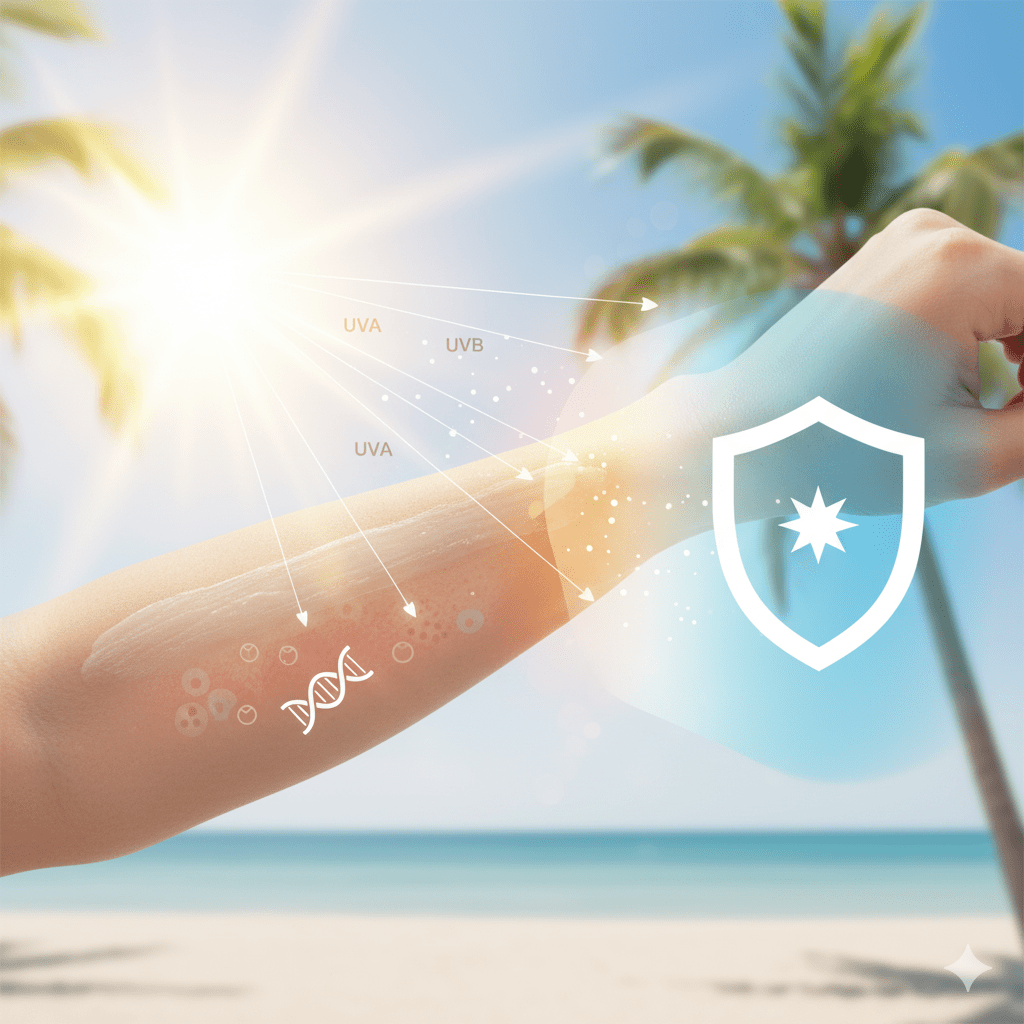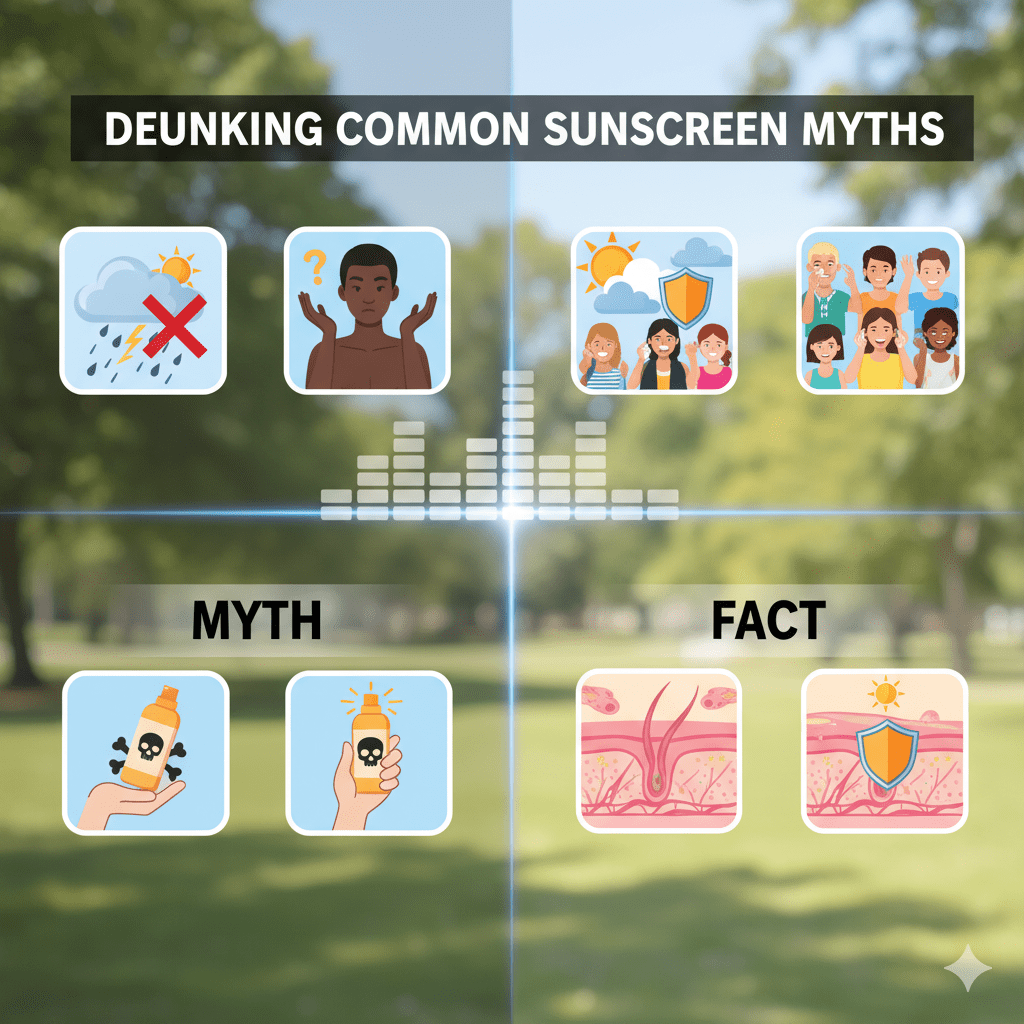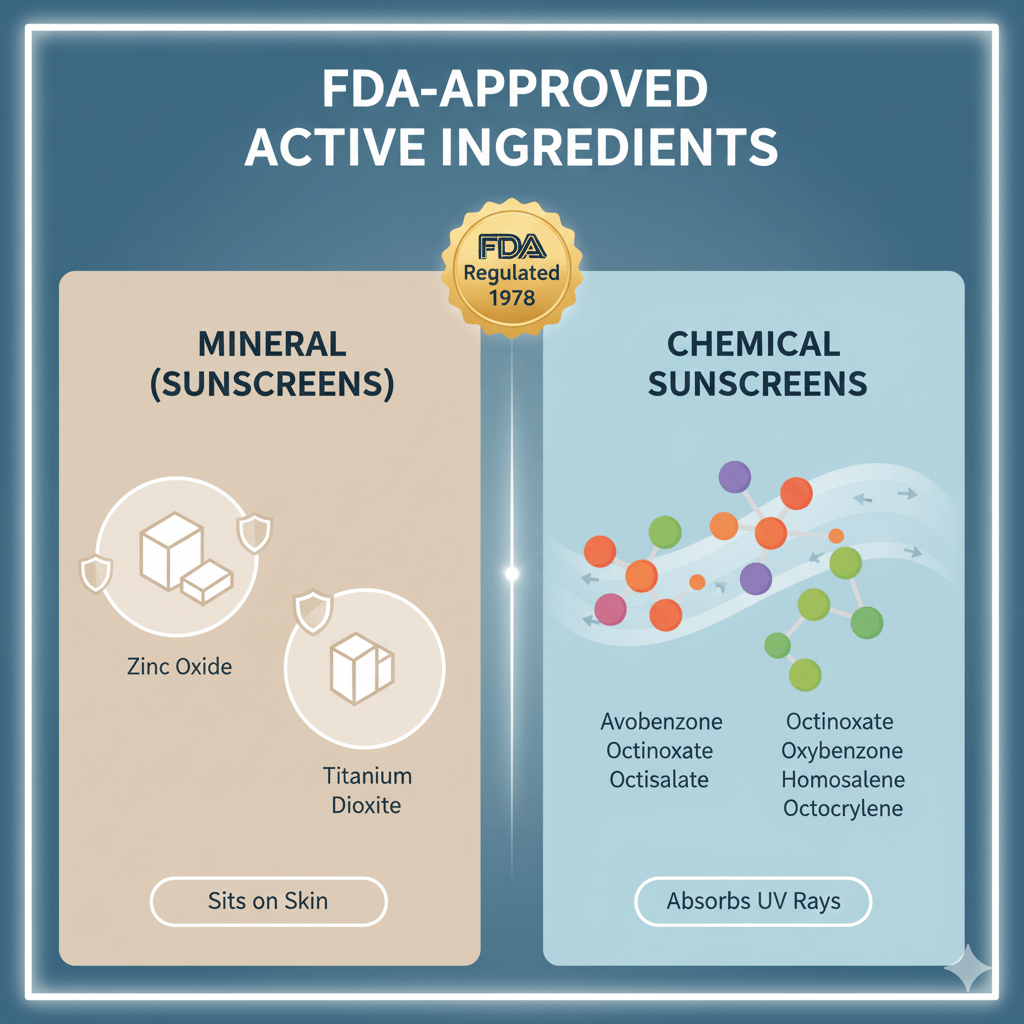Sunscreen is a skincare essential that has become synonymous with sun protection. While it’s often associated with beach vacations and hot summer days, its importance extends far beyond preventing a simple sunburn. Sunscreen is a critical tool in protecting your skin from the harmful effects of ultraviolet (UV) radiation. It can lead to premature aging, skin damage, and even skin cancer. This blog will delve into the history of this vital product, explain why it’s an essential step for your skin. Also it provide a practical guide to using it effectively.
Click here to know more about some popular and suggested sunscreens in the market
A Brief History of Sunscreen

The concept of sun protection is ancient, with various civilizations using natural remedies for centuries. Ancient Egyptians used extracts from rice bran, jasmine, and lupine to protect their skin from the sun. The Greeks used a mixture of olive oil and sand, while the Himba women of Namibia still use a mixture of ochre and butterfat.
The first chemical sunscreen was developed in Germany in the late 19th century. The modern era of sunscreen began in 1938. That’s when Swiss chemist Franz Greiter created “Gletscher Crème” (Glacier Cream). He did so after getting a severe sunburn. Greiter coined the term “Sun Protection Factor” (SPF) in 1974. The US Food and Drug Administration (FDA) adopted it in 1978. This action officially regulated the growing sunscreen market.
Why Sunscreen is So Important

The sun’s UV radiation comes in two primary forms that reach the Earth’s surface: UVA and UVB. Both are harmful to your skin.
- UVB rays are the main cause of sunburn and are a major contributor to skin cancer.
- UVA rays penetrate deeper into the skin, contributing to premature aging, such as wrinkles and fine lines, and also increasing the risk of skin cancer.
Sunscreen acts as a barrier. It either absorbs UV rays and turns them into heat. This is how chemical sunscreens work. Or, it physically deflects the rays away from the skin. This is what mineral sunscreens do. Using sunscreen correctly and consistently helps reduce your risk of skin cancer. This includes melanoma, the most dangerous type.
What Does SPF Mean and How to Choose It
SPF, or Sun Protection Factor, is a measure of how well a sunscreen protects your skin from UVB rays, the kind that cause sunburn. It’s a key number on any sunscreen bottle, but it can be misleading if not understood correctly.
Think of it this way: an SPF 30 sunscreen allows you to stay in the sun without getting burned 30 times longer than if you were wearing no sunscreen at all. For example, if your skin would normally start to redden after 10 minutes of sun exposure, an SPF 30 would theoretically extend that time to 300 minutes (10 minutes x 30).
However, it’s important to remember that SPF is a measure of protection against UVB rays, not UVA. This is why you should always choose a sunscreen labeled “broad-spectrum,” which means it protects against both types of UV radiation.
How to Choose Your SPF:
- SPF 30 is the minimum for daily use: The American Academy of Dermatology recommends an SPF of 30 or higher. An SPF 30 blocks about 97% of UVB rays, while an SPF 50 blocks about 98%. The difference in protection is minimal, so a higher SPF doesn’t mean you can stay in the sun for an unlimited amount of time.
- Consider your activities: If you’re spending a significant amount of time outdoors, especially in strong sun, or you have a history of sun sensitivity, a higher SPF (50+) may be a better choice.
- Don’t rely solely on SPF: No sunscreen blocks 100% of UV rays. The best practice is to combine sunscreen with other forms of sun protection, such as seeking shade, wearing protective clothing, and a wide-brimmed hat.
Click here to know more about some popular and suggested sunscreens in the market
Debunking Common Sunscreen Myths

There’s a lot of misinformation about sunscreen that can lead people to skip this vital protection. Let’s set the record straight:
- Myth: You don’t need sunscreen on cloudy days or in the winter.
- Fact: Up to 80% of the sun’s UV rays can penetrate clouds. Even on a cool, cloudy day, you are still at risk of sun damage. UV rays are present year-round, and reflection from snow can even increase your exposure in the winter.
- Myth: People with darker skin tones don’t need sunscreen.
- Fact: While melanin provides some natural protection, it is not enough to prevent sun damage or skin cancer. People of all skin tones can get sunburned and are at risk for skin cancer. In fact, skin cancer in individuals with darker skin is often diagnosed at a later, more dangerous stage because of this common misconception.
- Myth: Sunscreen causes cancer.
- Fact: There is no scientific evidence to support this claim. Extensive research and regulation by health organizations like the FDA confirm that sunscreen is safe and effective in reducing the risk of skin cancer. The real danger comes from the sun’s UV radiation, which is a known cause of skin cancer.
- Myth: A “base tan” protects you from future sunburns.
- Fact: A tan is a sign of skin damage. It is your body’s response to UV injury. A base tan offers a very minimal SPF—the equivalent of about SPF 3 or 4, which is nowhere near enough to protect you. Tanning beds are not a safe way to get a base tan; they expose you to high levels of harmful UV rays.
- Myth: Makeup with SPF is enough for daily protection.
- Fact: While makeup with SPF offers a small amount of protection, it is not enough. You would need to apply a very thick layer of foundation or powder to get the SPF listed on the label, and you would need to reapply it every two hours. It’s best to use a dedicated broad-spectrum sunscreen under your makeup.
Pros and Cons of Sunscreen Use
Pros:
- Prevents Sunburn: Sunscreen is highly effective at preventing painful sunburns.
- Reduces Skin Cancer Risk: A wealth of research supports the use of sunscreen as a key preventative measure against both melanoma and non-melanoma skin cancers.
- Fights Premature Aging: Sunscreen protects against photoaging, helping to maintain a youthful appearance by preventing wrinkles, fine lines, and sun spots.
- Protects All Skin Tones: All individuals, regardless of their skin tone, are susceptible to the sun’s harmful effects and should use sunscreen.
Cons:
- Potential for Skin Irritation: Some chemical sunscreens can cause skin irritation or allergic reactions in sensitive individuals.
- Misconception of Complete Protection: No sunscreen blocks 100% of UV rays. Some people may feel a false sense of security and stay in the sun for longer periods, increasing their overall exposure.
- Environmental Concerns: Some chemical ingredients, like oxybenzone and octinoxate, have been linked to potential harm to coral reefs and marine life. This has led to the development of “reef-safe” sunscreens, which typically use mineral filters.
FDA-Approved Active Ingredients

In the United States, the FDA has a list of approved active ingredients for sunscreens. These are generally divided into two categories:
- Mineral (or Physical) Sunscreens: These sit on top of the skin and create a physical barrier. The two primary FDA-approved ingredients are:
- Zinc Oxide: Provides broad-spectrum protection against both UVA and UVB rays.
- Titanium Dioxide: Primarily protects against UVB and some UVA rays.
- Chemical Sunscreens: These absorb UV radiation and release it as heat. Some of the FDA-approved ingredients include:
- Avobenzone
- Octinoxate
- Oxybenzone
- Octisalate
- Homosalate
- Octocrylene
It’s worth noting that while other countries have approved additional, more modern UV filters, the FDA’s approval process for new ingredients is a lengthy one.
Country-Wise Usage Data
Sunscreen usage varies significantly around the world. In Europe, countries like Spain show a high degree of sun-safety caution, with half of consumers using sunscreen to prevent burning or cancer. In Germany, there’s a trend towards higher SPF products. East Asia, particularly Japan, has a very high market share for sun protection products, reflecting a cultural emphasis on fair skin. In contrast, studies in some regions, like the one in Canada and others, have shown that despite a good knowledge of sun hazards, the rate of consistent sunscreen use remains low.
Which Demographics Need it Most?
While everyone should use sunscreen, certain demographics require it most:
- People with Fair Skin: Individuals with pale skin, light-colored hair, and a history of sunburn are at a significantly higher risk of skin cancer.
- Children: Childhood and adolescence are critical periods for sun exposure, and damage from sunburns in youth can increase the risk of skin cancer later in life. Infants under six months should be kept out of direct sunlight and wear protective clothing instead of sunscreen.
- Outdoor Workers and Athletes: People who spend a significant amount of time outdoors are exposed to a higher dose of UV radiation and should be especially diligent about sun protection.
- Individuals with a Family History of Skin Cancer: Genetic predisposition is a major risk factor.
Significant Precautions and How to Use
Before Using:
- Patch Test: If you have sensitive skin, perform a patch test on a small area of your skin to check for any allergic reactions or irritation.
- Check the Label: Look for “broad-spectrum” on the label, which indicates protection against both UVA and UVB rays. Choose an SPF of 30 or higher.
- Flammability: Be aware that some spray sunscreens contain flammable ingredients. Avoid using them near open flames or while smoking.
How to Apply:
- Apply Liberally and Evenly: Most people don’t use enough sunscreen. A general rule of thumb is about one ounce (the amount in a shot glass) to cover your entire body.
- Don’t Forget Key Areas: Apply to all exposed skin, including your face, neck, ears, the tops of your feet, and the back of your hands. Don’t forget your lips—use a lip balm with SPF.
- Direct Application on Face: Yes, you can and should apply sunscreen directly to your face as part of your daily skincare routine. However, it’s best to use a product specifically formulated for the face, as these are often lighter, non-comedogenic (won’t clog pores), and less likely to cause breakouts. Apply it as the last step in your skincare routine, right before your makeup.
- Apply in Advance: Apply sunscreen at least 15-30 minutes before going outside to allow it to be absorbed.
- Reapply Regularly: Reapply at least every two hours, and more often if you’re swimming or sweating. No sunscreen is “waterproof,” only “water-resistant” for a specified period (40 or 80 minutes).
- Combine with Other Measures: Sunscreen should be used as part of a holistic sun safety approach. Seek shade, wear protective clothing, and a wide-brimmed hat, and use sunglasses with UV protection.
Conclusion
Sunscreen is more than just a cosmetic product; it’s a vital part of your health and wellness routine. By understanding its history, purpose, and proper application, you can take a significant step in protecting your skin from the damaging effects of the sun. Make it a daily habit, and your skin will thank you for years to come.
Relevant Reference Links:
- American Academy of Dermatology: https://www.aad.org/public/everyday-care/sun-protection
- Skin Cancer Foundation: https://www.skincancer.org/
- FDA’s Sunscreen Information: https://www.fda.gov/drugs/understanding-over-counter-medicines/sunscreen-how-help-protect-your-skin-sun
- CDC Sun Safety Tips: https://www.cdc.gov/cancer/skin/basic_info/sun-safety.htm
- Environmental Working Group (EWG) Sunscreen Guide: https://www.ewg.org/sunscreen/
Read more blogs at : Okjango.com


